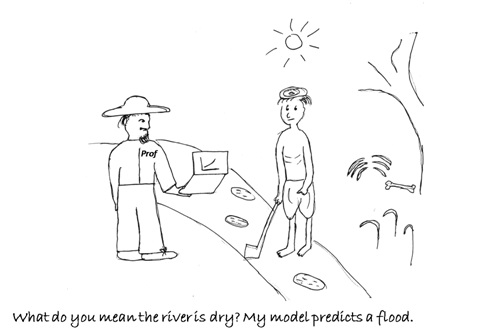India’s rivers and aquifers are drying. ~70% of our food is produced from unsustainable groundwater irrigation, and groundwater is rapidly disappearing. This has serious implications for continued economic growth. On one hand, there is widespread public and political concern about India’s water. Recent campaigns by major spiritual leaders like Isha Foundation’s Rally for Rivers and the Art of Living’s River Rejuvenation campaigns have attracted massive support. There is clearly an economic argument for addressing India’s water crisis – it has been estimated that the Cauvery riots of 2016 resulted in a loss of Rs. 25,000 crores and the Chennai floods a loss of Rs 15,000 crores. Yet, on the other hand, the trajectory of the country toward a doomed water future seems to be accelerating, not slowing down.
The Indian science community is at least partially to blame, as it has not done its bit. On querying Google Scholar on virtually any water crisis or conflict in India, it becomes quickly apparent that answers to most questions do not exist. For instance, in the context of the Cauvery, have flows into reservoirs declined over time? Has rainfall in the Western Ghats declined? Has irrigation area in Karnataka increased or decreased? In contrast, a similar search on the Mekong, Murray Darling or Colorado rivers yields hundreds of papers. It is clear that there is a big disparity in both the number of papers and their usefulness to public discourse.
But why aren’t we able to diagnose and solve the problem? It’s not the money. MoES, DST, MoWR, CGWB spending on water research is comparable to USGS and US NSF. Rather, the spending produces very few publications that are of any use. There are several reasons why this might be happening, and our higher education system and research funding system are partially to blame.
Why is Indian science failing to address the crisis?
First, there is no direct link between the science being done and the real-world conditions in which it is applied. The right questions are not being asked. Research in individual disciplines has become more focused, with most scholars becoming highly specialised in narrower topic areas. This starts right at the undergraduate level – most engineering courses do a poor job of training students to think critically about the broader social implication of engineering design decisions. Thus, a civil engineer may be trained to write an equation for losses from an irrigation canal or to write a programme to “optimally” manage a reservoir, but often they are completely blind to the social implications of a particular dam or canal design. Who are the winners and losers if one design is chosen over the other? Are the implicit assumptions about human behaviour valid? Who gets to decide what goes into the optimisation objective and constraint equations? Should aquatic species be included; the concerns of the landless? This requires some understanding of the fields of ecology and anthropology; but how is that to be brought in?
First, there is no direct link between the science being done and the real-world conditions in which it is applied. The right questions are not being asked.
Departments only hire faculty who have degrees from their own discipline, perpetuating the cycle. Collaboration between departments might be a solution, but not only is there a lack of communication, there is snobbery too. There is a clear hierarchy: engineering is more prestigious than science or economics; other social sciences followed by humanities are at the bottom of the heap! This prevents meaningful dialogue between different disciplines. And for the most part, cross-discipline learning isn’t even possible in a landscape where colleges are segregated by discipline and faculty and students are not incentivized to exchange ideas.

Second, this blinkered approach carries over into the bureaucracy. Irrigation department positions start from Assistant Engineer and go all the way to Chief Engineer. There is simply no place to employ an anthropologist or sociologist or an expert on negotiations with indigenous communities. Once projects are commissioned, they are operated based on the dictates of local politics and in the absence of post-facto monitoring, some beneficiaries never see the water. Indeed, there are very few serious post-facto analyses of projects in India, making it virtually impossible to validate or rebut claims.
Third, most faculty in elite engineering or science schools have stopped measuring anything or even going to their field sites. The typical approach is to develop a computer simulation model by writing a set of equations that govern energy and water flow and using secondary data from the government. This sounds simple enough, except in reality, the equations are highly dependent on assumptions or parameters, which are read off tables developed for the United States or Europe.
Another problem is that observations by government agencies are sometimes wrong or fudged, as even a cursory visit to the field would have revealed. And in many places, people have altered the watersheds so much that the original equations don’t even hold. If everything is either simulated or measured from space, researchers have no way of knowing that the data and equations they have used are incorrect and the calibrations used for satellites don’t apply to India. So the models end up being garbage-in-garbage-out!

Finally, much of the research being done is “self-referential”. The science does not answer questions that matter to people, or reference major contemporary debates. The work is not communicated beyond narrow academic audiences. Too many times, papers from prestigious Indian institutions state that the purpose of their research is to build a model. But for what larger purpose? Since Indian institutions do not push faculty to show “broader impact” (as say US NSF does) they feel no need to do this. As long as they can get published in some obscure journal life goes on.

What needs to be done?
To do useful science that can tackle India’s looming water crisis, we need to start with the problem, find the science gaps and seek to address them. The idea that for the science to be usable and acceptable, the research itself needs to be built and validated by consulting stakeholders – an idea that gaining prominence internationally. However, this requires a fundamental rethinking of how science is done; a change in mindset and willingness to tolerate “messiness”. It requires natural scientists to be willing to see social scientists as people with useful expertise. It also requires that each group be willing to make their work comprehensible; to communicate as well as listen to the other, as well as to all stakeholders – activists, the government, think tanks and the general public.
Obviously, the article paints institutions and faculty with a broad brush, and there are many exceptions. But overall there is need for reform. We need to train a new generation of interdisciplinary researchers and leaders to do all these tasks and create the institutions and funding agencies that can nurture and reward them.

1 comment
Dear Mam, Excellent ! time to contemplate, deciphered the severity in simple language.